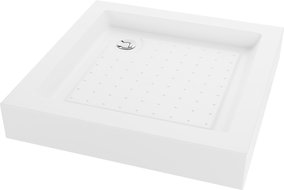
Siphon - an inconspicuous yet extremely important part of the plumbing and sewage system. Connected to the vertical sewer pipe, it is responsible for efficiently draining used water from the shower. Proper installation prevents unpleasant smells and gases from coming from the sewer into the bathroom. When planning to install a shower tray, it's worth investing in a high-quality product that ensures effective operation. Below, we present guidelines to follow when choosing a shower tray siphon.
Shower Tray Siphon - Important Selection Criteria
Sewer siphons differ in shape, size, and the type of material they are made from. The latter criterion is linked to their quality and price. It is important for the shower tray siphon to be made from a durable material that is also resistant to rust. This will protect us from problems related to leaks, which may occur due to excessive use of the device.
It is also necessary to match the shape and size of the siphon to the installed device. This mainly involves the location and method of installation, the height of the shower tray, the diameter of the drain, the associated flow capacity, and the ability to connect an overflow. Also important is the method of siphon unclogging since hair, soap residues, etc., accumulate there, requiring frequent cleaning. Read what to pay attention to and choose a model that will operate without fail and serve you for a longer time.
What Height Should a Shower Tray Siphon Be?
Siphons vary in height - from about 40 mm to over 100 mm - allowing them to be matched to the depth of the shower tray and the method of laying the sewage installation. The height of the siphon we plan to buy depends on the installation location and the height of the device for which it is intended. Our task is to select a shower tray siphon that will fit under its bottom or the floor surface. For flat shower trays or walk-in cabins, it is advisable to choose siphons with the smallest height possible, e.g., 4 cm. It may happen that the shower tray installation will require the floor to be chiselled to place the entire drain. Therefore, it is good to plan the purchase of individual elements already at the design stage of the bathroom, i.e., planning the type of shower cabin and the model of the shower tray.
A tall shower tray, whose depth exceeds 21 cm, can be equipped with a slightly higher drain set with an overflow system similar to what is installed in bathtubs. Turning or pressing the tile in the overflow closes the water drain from the shower tray. This is especially useful in bathrooms where there is only a shower cabin and no bathtub. The construction of modern drains guarantees protection against water backflow and the escape of unpleasant odors from sewer pipes.
Flow Capacity of a Shower Tray Siphon
The flow capacity of the siphon plays a very important role in its selection. It should be adjusted to the performance of the tap or shower panel, considering the amount of water emitted by the devices installed in the shower cabin. Siphons for shower trays differ quite significantly in flow capacity, which can range from 30 to over 70 l/min. The amount of handled sewage does not depend on the height of the water seal but on its construction and the size of the drain opening. Standard openings have a diameter of 50 mm or 90 mm. All shower trays, especially flat ones, must have an extremely efficient system for removing used water. Otherwise, it poses a risk of flooding the bathroom.
If we intend to install a rain shower head in the shower cabin, we must consider its size, and consequently, the amount of water used and the ability to drain it off. Large rain showers can use up to 40 liters of water per minute, therefore a siphon with a larger drain will be necessary. For smaller rain showers, which emit about 18 liters of water per minute, a drain with a diameter of 50 mm will suffice. Applications requiring greater flow efficiency are also necessary for cabins featuring hydromassage. It is also worth considering a similar drain in high shower trays used as small bathtubs.
Does the Way the Siphon is Cleaned Matter for Choosing a Specific Model?
Everyone knows very well that the shower tray drain and siphon are places where numerous contaminants accumulate. To ensure proper sewage flow and optimize throughput, the sewer system's draft must be maintained. Since the shower tray or bathtub siphon is placed under the casing, in a hard-to-reach place, it is best to choose a model whose cleaning is uncomplicated. An example of such a device is the bell siphon. It is characterized by its low height and can, therefore, be used even in very low shower trays. Most importantly, this type of siphon can be disassembled and cleaned from the top by removing individual elements.
The tube siphon, also known as the self-cleaning siphon, is recommended. It consists of a single element, i.e., a tube bent in the shape of a "U" or "S". In this model, contaminants that could clog the siphon settle more slowly due to its horizontal construction. Each passing of water through it causes a cleanse. An additional advantage of this type of siphon is its considerable capacity. Thanks to this, they accommodate more water and are more resistant to drying out. They usually have a smaller cross-section than a pipeline, so anything that manages to get through them will not get stuck further along.



















